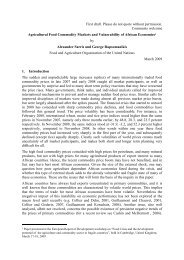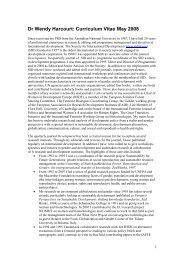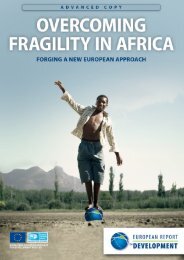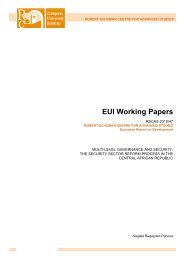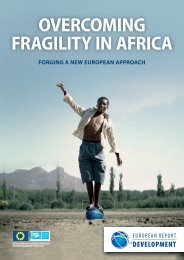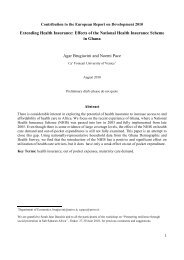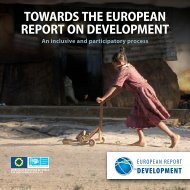Samuel Gayi - ERD
Samuel Gayi - ERD
Samuel Gayi - ERD
You also want an ePaper? Increase the reach of your titles
YUMPU automatically turns print PDFs into web optimized ePapers that Google loves.
WTO and the Challenges forAfrican Agriculture<strong>Samuel</strong> K. GAYISpecial Unit on CommoditiesUNCTADGeneva, Switzerland
OutlineCharacteristics of African agriculture;Agricultural performance in SSA since the 1980s,;Overview of WTO Agreement on Agriculture andthe Agreements on SPS and TBT;Challenges emanating WTO & AoA for SSA -focus on possible food security implications.Policy perspectivesConcluding remarks2
Characteristics of African Agriculture Main source of livelihood:64 percent of Africa’s total population.34 percent of continent’s GDP; 40 percent of export earnings (World Bank, 2008).> 90 percent of total population lives in lowincomecountries, agriculture plays more criticalrole.3
Sector plagued with problems.. Natural characteristics Geography & environment (Sachs & Warner, 1997; Bloom& Sachs, 1998); Lack of access to sea, tropical climate.Socio-economic factors Patterns of land ownership – ltd indiv. Property rights, Depleted human capital – e.g 70% of known HIV/AIDScases in Africa; Zambia – 20% of 15-24 year-olds in 1990 had died by 2000(WB)4
Low Public & Private InvestmentsR&D, transport and energy infrastructure;Agric R&D expenditure grew at 1.4 pa, 1974-2000;Pub expend on agric fell from 7.5% to 6% of GDP(1984-2004);NEPAD CAADP – 10% govt budget to agric by2008;Sharp falls in ODA: Total ODA to African agricfell from $3.2 billion to $1.2 billion (1988-2004);5
ODA: Agric, fisheries, forestry as proportion oftotal ODA, 1967-2006Figure 4. DAC ODA to Agriculture, fisheries and forest as proportion of total DAC ODA, 1967-200614%12%10%8%6%4%2%0%619681970197219741976197819801982198419861988199019921994199619982000200220042006
Low Public & Private InvestmentsLow Investments in: Irrigation & other productivity enhancingtechnology;Low cereal yields Stagnated at 1000kg/ha/arable land since 19847
Figure 5. Cereal yields, SSA and other developing regions54.543.5Yie ld s, to n n e s p e r h e cta re32.521.510.50196 1196 4196 7197 0197 3197 6197 9198 2198 5198 8199 1199 419 972 0 0 02 0 0 3Developing countriesSub-Saharan AfricaSouth AsiaEast Asia & PacificLatin America & CaribbeanYearsSource: FAO, 2008a.8
Cereal yields: Africa and Asia4.5Africa Wheat4.0Africa Rice3.5Africa MaizeAsia WheatAsia3.0Asia RiceMT/Ha2.52.0Asia MaizeAfrica1.51.00.50.01960 1965 1970 1975 1980 1985 1990 1995 2000 20059
Agricultural performanceSSA’s agric production fell 5% (1980-2001) vrs 40%increase for DCsAfrica’s share of world agric exports fell from 8 to 2% over past 40 years;Continent moved from net food exporter to netfood importer in 1988.Net food trade balance registered a deficit of $2.4billion (1988), increasing to $4.55 billion, beforedecline to $3.6 billion in 1994.Deficit on annual average net food trade balance was$8.4 billion during 2004-2006, almost all incurred bycountries in North Africa.10
Food Trade balance, Africa, 1995-2006Fig. -- Food trade balance for Africa and subregions,1995-2006Billion USD, current6.004.002.000.00-2.00-4.00-6.00-8.00-10.00-12.001995 1996 1997 1998 1999 2000 2001 2002 2003 2004 2005 2006Africa North SSA11
Africa's trade in food crops: case of maize1.81.61.4value ($billion)1.210.80.60.40.2ImportsExports01960 1965 1970 1975 1980 1985 1990 1995 2000 200512
400Agricultural exports: Countriesgaining or losing ground350$ million300250200150ZambiaBurkina FasoAlgeriaAngola1005001960 1965 1970 1975 1980 1985 1990 1995 2000 200513
. Agriculture as a proportion of GDP, 1980-200530%25%20%15%10%Source: UNCTAD (2008a)5%Southern Asia Sub-Saharan Africa Latin America Eastern and South-Eastern Asia0%19801985199019952000200514
80%Proportion of agricultural output exported (%),1995-200670%60%Percentage50%40%30%20%10%0%1995 1996 1997 1998 1999 2000 2001 2002 2003 2004 2005 2006Southern Asia Sub-Saharan Africa Latin AmericaEastern and South-Eastern Asia15
Agricultural exports by value*, SSA and other developing regions, 1995-2006US dollars, millions1400001200001000008000060000400002000001995 1996 1997 1998 1999 2000 2001 2002 2003 2004 2005 2006Southern AsiaSub-Saharan AfricaLatin AmericaEastern and South-Eastern Asia16
SSA: Performance of Agriculture The contribution of agriculture to total output in SSAgenerally stagnated between 1980 and 2006 at about 19 percent. SSA is the region with the highest ratio of agriculture toGDP since 2000, a sign of its lack of structuraltransformation. Two-thirds of countries that remained commoditydependentin 2003-2005 are in Africa. But SSA countries have seen a modest increase in the valueof their agricultural exports compared to Latin America andEast and South East Asia.17
SSA: Performance of Agriculture, contd… Aggregate supply response of agricultural production toprice incentives is weak because of structural andinstitutional factors. Weak supply response to reforms also due to a one-sizefits-allreform package . Export volumes increased but not export value until 2002because of price volatility and falling prices of traditionalexport commodities. Over the last 20 years, only five countries recordedagricultural exports in excess of one-fifth of their GDP(Cote d’Ivoire, Ghana, Malawi, Seychelles, and Swaziland).18
SSA: Performance of Agriculture, contd…Slow progress in international trade diversificationin Africa.Only South Africa is part of the list of top 20horticultural exporters in 2000-2005, with anaverage market share of 2.3 per cent.Other top exporters of horticultural products inSSA include Morroco with a market share of justover 1 percent, followed by Kenya and Coted’Ivoire and less than 1 percent.19
SSA: Performance of Agriculture, contd..Overall, the continent's potential in commercialagriculture remains largely untapped.The region has generally not benefited fromproductivity gains and faces competition from anumber of countries (e.g. Brazil, Indonesia andVietnam on coffee and Malaysia on cocoa).To conclude: in most cases, the anticipated positiveimpact of trade liberalization on an export-ledgrowth did not materialise20
Africa & Asia: yield gapAfrica's cereal yield increases are lower than those ofAsia maize, rice and wheat.If Africa's yields were same as those of Asia it will haveproduced in 2005:• 42% more wheat• 100% more rice (twice the actual production) and• 137% more maizeThe yields of sorghum and millet have stagnated bothin Asia and AfricaMechanization and chemicals/fertilizers increasedyields in Asia; Africa, yields stagnated or declined21
Africa's potential food production: The case of maize and riceAfrica's potential food production: The case of maize and rice** = Africa's potential production (Africa's areas harvested x Asia' yield)Note: Without stars (**) is Africa's actual production trends120000000Rice Paddy100000000MaizeProduction in MT800000006000000040000000Rice Paddy**Maize**2000000001960 1965 1970 1975 1980 1985 1990 1995 2000 200522
WTO Agreement onAgriculture23
WTO AoAAgricultural trade is one of five new areas includedin the agenda of the Uruguay Round of tradenegotiations.The WTO-AoA was expected to initiate a processof greater liberalization in international agriculturaltrade through enhanced transparency in three mainareas: market access, domestic support andsubsidies.24
WTO AoA; SPS, TBTLDCs are required to tariffy non-tariff barriers(NTBs) and bind their tariffs, although within alonger time frame. But are exempted from allreduction commitments.Special and differential treatment (S&DT) measureswith respect to the implementation LDCs andNFICs, almost all countries in SSA.25
WTO AoA, contd..Negotiations on fully integrating agriculture intoWTO disciplines on-going in context of the DohaWork Programme;Limited progress made in the agricultural negotiationsduring Hong Kong WTO Ministerial Meeting in2005: Declaration does not call for the elimination ofdomestic subsidies in major developed countries.Formulas for cutting tariffs and subsidies, the socalledcore modalities, and treatment of sensitiveproducts were not resolved (Heydon, 2006).26
SPS and TBTAgreements on SPS and TBT also impact onagricultural exports;Agreement on SPS sets out the rules on foodsafety and animal and plant health standards.Objective of the Agreement on TBT is to ensureregulations, standards, testing and certificationprocedures do not create unnecessary obstacles27



